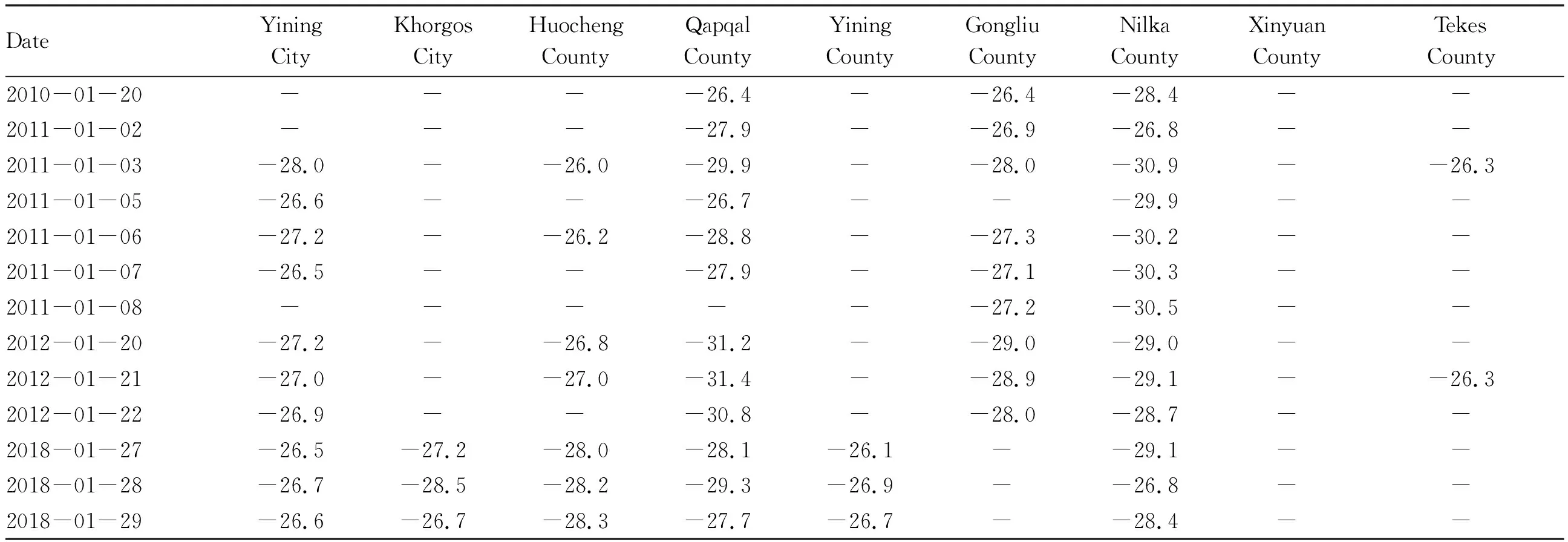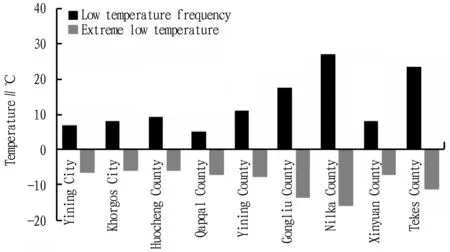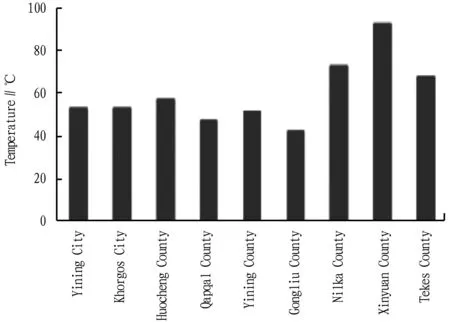Threats and Avoidance Measures of Frost Damage of ‘Shushanggan’ Apricot in the Ili River Valley
2021-07-21GuizhiCONGShuyingCHENYupingMAJinWANGYouSHI
Guizhi CONG, Shuying CHEN, Yuping MA, Jin WANG, You SHI
1. Forestry Academy of Ili Kazak Autonomous Prefecture, Ili 835000, China; 2. Meteorological Bureau of Ili Kazak Autonomous Prefecture, Ili 835000, China
Abstract [Objectives] To explore the threat factors of frost damage to ‘Shushanggan’ Apricot in the Ili River Valley, and to provide measures for avoiding frost damage. [Methods] Based on the meteorological data of the Ili River Valley counties and cities during the 12 years from 2010 to 2021 and using the critical low temperature of ‘Shushanggan’Apricot as the main factor, we comprehensively analyzed the threats of low temperature in winter in January and late frost in April in spring in the Ili River Valley. [Results] During the 12 years, there were 4 years of low temperature below the critical (-26—-28℃) of ‘Shushanggan’Apricot in the Ili River Valley counties and cities in January, accounting for 33.3%, and a total of 59 d. The frequency of occurrence was: Nilka County>Qapqal County>Yining City>Gongliu County>Huocheng County>Khorgos City>Yining County>Tekes County>Xinyuan County. In April, there were 9 years with a low temperature below the critical temperature (-0.6 ℃) flowering and fruit setting of ‘Shushanggan’Apricot, accounting for 75%, and a total of 134 d. The frequency of occurrence was: Nilka County>Tekes County>Gongliu County>Yining County>Huocheng County>Khorgos City>Xinyuan County>Yining City>Qapqal County. The low temperature threats of ‘Shushanggan’Apricot suitable cultivation areas were ranked as follows: Nilka County>Gongliu County>Tekes County>Qapqal County>Huocheng County>Yining City>Yining County>Khorgos City>Xinyuan County. Combined with the observation and survey of frost damage on the spot, we comprehensively analyzed and evaluated the cultivation area of ‘Shushanggan’Apricot in the Ili River Valley: three counties (Nilka County, Gongliu County, and Tekes County) in the eastern region, except Xinyuan County, suffered frequent late frost damage, are suitable areas for the cultivation of ‘Shushanggan’ Apricot; three counties and two cities in the western region (Qapqal County, Huocheng County, Yining City, Yining County, Khorgos City) and Xinyuan County in the eastern region are suitable areas for ‘Shushanggan’ Apricot. The inversion zone at an altitude of 820-1 100 in the valley is the superior area for ‘Shushanggan’ Apricot. [Conclusions] We explored the suitable areas in the origin area of ‘Shushanggan’ Apricot, and came up with measures to avoid frost damage, to provide a reference for the development of ‘Shushanggan’ Apricot.
Key words ‘Shushanggan’ Apricot, Ili River Valley, Frost damage, Threats, Avoidance measures
1 Introduction
‘Shushanggan’ Apricot is a native apricot variety unique to the Ili River Valley in Xinjiang. It can be freshly eaten or processed into dried apricot. In recent years, the sales of fresh apricots have been well received by consumers, so the market prospects are excellent. ‘Shushanggan’ Apricot is a native species in the Ili River Valley. Its cultivation is greatly affected by climatic factors. The extreme low temperature in winter and late frost in spring bring frost damage to ‘Shushanggan’ Apricot tree body and flower buds, and are the main reasons for its unstable yield. In the past two years (2020 and 2021), ‘Shushanggan’ Apricot in the Ili River Valley in the spring have suffered cold spell. Based on the meteorological data of the Ili River Valley counties and cities during the 12 years from 2010 to 2021 and using the critical low temperature of ‘Shushanggan’ Apricot as the main factor, we comprehensively analyzed the threats of low temperature in winter in January and late frost in April in spring in the Ili River Valley, explored the suitable areas in the origin area of ‘Shushanggan’ Apricot, and came up with measures to avoid frost damage, so as to provide a reference for the development of ‘Shushanggan’ Apricot.
2 Hazards of extreme low temperature in winter
According to previous studies, the low-temperature semi-lethal temperature of ‘Shushanggan’ Apricot branches is -26—-28 ℃. The degree of frost damage is closely associated with the duration of low temperature. Based on the winter extreme low temperature data of Meteorological Bureau of Ili Kazak Autonomous Prefecture from 2010 to 2021, we extracted and analyzed the data of the low temperature below the critical value of ‘Shushanggan’ Apricot in the seven counties and two cities in the Ili River Valley in January. The analysis results indicate that during the 12 years, these counties and cities experienced four years (2010, 2011, 2012, and 2018 respectively.) of low temperature below the critical temperature (-26—-28℃), accounting for 33.3%, and a total of 59 d. The frequency of occurrence of low temperature was: Nilka County>Qapqal County>Yining City>Gongliu County>Huocheng County>Khorgos City>Yining County>Tekes County>Xinyuan County. Specifically, the duration below the critical low temperature was up to 6 d from January 2 to 8, 2011. In Yining City, Qapqal County, Gongliu County, and Nilka County, ‘Shushanggan’ Apricot experienced the most severe forst damage, the highest frequency appeared (13 d) in Nilka County. On January 21, 2012, Qapqal County suffered an extreme low temperature (-31.4 ℃), which was the most lowest in 12 years (Table 1, Fig.1).

Table 1 Low temperature below the critical temperature of ‘Shushanggan’ Apricot in the Ili River Valley in January during 2010-2021 (℃)

Fig.1 Low temperature below the critical temperature and frequency of damage to ‘Shushanggan’ Apricot in the Ili River Valley in January during 2010-2021
3 Hazards of late frost and cold spell in spring
In the Ili River Valley, there are frequent activities of late spring and cold spell in April, and the ‘Shushanggan’ Apricot flowering period generally occurs in early April. Therefore, the flowering and young fruit periods are often threatened, and the degree of frost damage is much associated with the duration of low temperature. The critical temperature of frost damage for apricot tree flowers and fruits in different phenological stages are: -3.9 ℃ in the initial flowering period, -2.2 ℃ in the full flowering period, and -0.6 ℃ in the fruit setting period. When the temperature is lower than these values, the flowers and fruits are susceptible to frost damage. The critical temperature for low-temperature tolerance of mountain apricot during flower bud germination is -4 ℃, and at the flowering and young fruit stage of mountain apricot are -3 ℃ and -1 ℃ respectively. Like other apricot trees, under the same degree of frost damage, the order of cold tolerance at flowering stage from strong to weak of ‘Shushanggan’ Apricot is: budding stage>flowering stage>young fruit stage. The low temperature tolerance of the various parts of the bloomed flower organs is not the same. The strongest resistance to low temperature is the calyx, followed by the stamens and petals, and the weakest is the pistil. Once the bloomed flowers are frozen, the pistil is the weakest and would die first, the calyx is blistered, and the water in the ovary freezes and peels, and finally flower organs lose their vitality.
Based on the meteorological data of the Ili River Valley counties and cities during the 12 years from 2010 to 2021, we analyzed the data of low temperature below the critical temperature (-0.6 ℃) flowering and fruit setting of ‘Shushanggan’ Apricot. As a result, there were 9 years with a low temperature below the critical temperature (-0.6 ℃) flowering and fruit setting of ‘Shushanggan’ Apricot, accounting for 75%, and a total of 134 d. The frequency of occurrence was: Nilka County>Tekes County>Gongliu County>Yining County>Huocheng County>Khorgos City>Xinyuan County>Yining City>Qapqal County. The extreme low temperature occurred in Nilka County, -18.5 ℃ on April 1, 2015. During these 12 years, these counties and cities experienced four years (2010, 2011, 2012, and 2018, respectively) of low temperature below the critical temperature, accounting for 33.3%. There were 3 years free of frost damage (2012, 2016, and 2019), accounting for 25%. Especially, the longest duration of extreme low temperature during these 12 years appeared in April 1, 2015 in these counties and cities. Four years suffered two times of late spring cold (2010, 2014, 2018, and 2021), especially the longest duration of low temperature in April 2021, more than 90% young fruits of ‘Shushanggan’ Apricot were frozen and there would be no harvest, as shown in Table 2 and Fig.2.

Table 2 Low temperature hazards of late frost (below -0.6 ℃) in April in Ili River Valley during 2010-2021

Fig.2 Low temperature and frequency of late frost (below -0.6 ℃) in April in Ili River Valley during 2010-2021
4 Evaluation of the frost damage threats and suitable cultivation areas
From the comprehensive analysis of the extreme low temperature below the critical temperature (-26—-28 ℃) in January and the critical temperature below the critical temperature (-0.6 ℃) in April (-0.6 ℃) and their frequency in the Ili River Valley during the 12 years from 2010 to 2021, it can be known that the lower the extreme low temperature value and the greater the occurrence frequency, the more serious the threats of frost damage to ‘Shushanggan’ Apricot. The composite value of extreme low temperature and occurrence frequency can reflect the threats of frost damage. Comprehensive analysis results of low temperature threats was: Nilka County>Gongliu County>Tekes County>Qapqal County>Huocheng County>Yining City>Yining County>Khorgos City>Xinyuan County, indicating that ‘Shushanggan’ Apricot in area of Xinyuan County has the smallest frost damage, while Nilka County has the largest frost threats (Fig.3). The above analysis is consistent with the actual occurrence of frost damage in counties and cities of the Ili River Valley, as shown in Table 3.

Fig.3 Comprehensive analysis of extreme low temperature and frequency of ‘Shushanggan’ Apricot in Ili River Valley during 2010-2021

Table 3 Comprehensive ranking of low temperature hazards below the critical temperature in ‘Shushanggan’ Apricot production area of the Ili River Valley during 2010-2021
Due to the influence of the Tianshan Mountains, the Ili River Valley is surrounded by mountains on northern, eastern, and southern sides, forming a trumpet-shaped valley that opens to the west. Along the Tianshan Mountains, there is an obvious temperature inversion effect. The diversification of the topography of the Ili River Valley, mountains and rivers creates a microclimate environment with diverse micro-topography in different areas, which makes some areas of orchards sheltered from frost damage. For example, on April 25, 2021, the orchard in the Heishantou area in Musi township of Nilka County where we surveyed, at an altitude of 860 m, is a typical northern sun slope with a slope of 5 degrees, backed by Heishantou, and the black rock absorbs a large amount of solar heat and conduction affects nearby orchards, thus the entire 26.7 ha orchard was sheltered from frost damage. For another example, the Mr. Luo’s Orchard on the northern slope of Dadamutu Township, Yining City, with an altitude of 750-790 m and a slope of 7.8 degrees, the apricots nd peaches in the orchard in the horizontal direction were not damaged by freezing, while other orchards with the same management level at an altitude of 670 m suffered 60% frost damage. According to the analysis of Wang Jinet
al.
on frost damage to ‘Shushanggan’ Apricot from 2010 to 2015, ‘Shushanggan’ Apricot suffered level 3-4 frost damages in plain area at an altitude of 700-750 m; in the sub-suitable area along the northern mountain slope, at an altitude of 750-800 m, ‘Shushanggan’ Apricot suffered level 2-3 frost damages; in the suitable area for vertical cultivation of fruit trees on the northern hillside, level 1 frost damage occurred in areas above 820 m above sea level, which has little impact on ‘Shushanggan’ Apricot young or grown-up orchards. Based on the comprehensive analysis of the specific frost damage of forests and fruits in different regions of the Ili River Valley for many years, the areas suitable for cultivation of ‘Shushanggan’ Apricot are as follows: three counties (Nilka County, Gongliu County, and Tekes County) in the eastern region, except Xinyuan County, suffered frequent late frost damage, are suitable areas for the cultivation of ‘Shushanggan’ Apricot; three counties and two cities in the western region (Qapqal County, Huocheng County, Yining City, Yining County, Khorgos City) and Xinyuan County in the eastern region are suitable areas for ‘Shushanggan’ Apricot. The inversion zone at an altitude of 820-1 100 in the valley is the superior area for ‘Shushanggan’ Apricot.5 Measures for avoidance of frost damage
In spring, it is necessary to pay attention to weather conditions and changes and combine various cold protection measures during the late frost occurrence.
(i) To avoid late frost damage to ‘Shushanggan’ Apricot, the first step is to make scientific plan for the orchard construction, select the suitable cultivation area, and the groundwater level should not be too high. (ii) Setting protective forests around the orchard can produce good protective effects. According to experiments, for apricot orchards with perfect shelterbelts, the frost duration will end 3-5 d earlier, and the temperature in the flowering garden will increase by 0.5 ℃. (iii) It is necessary to make careful management of the orchard to enhance the resistance of the fruit trees. (iv) Whitening the tree body can not only eliminate the overwintering pests and diseases on the trunks, but also can effectively reflect sunlight to a certain extent, reduce the temperature of the branches and trunks, thereby delaying flowering and avoiding the late frost damage. Whitening agent formula: 10 kg quicklime, 1 kg sulfur powder, 1 kg salt, 0.1 kg vegetable oil, and 20 kg water. (v) During flowering period of ‘Shushanggan’ Apricot, it is necessary to pay special attention to weather changes, conduct irrigation in early spring before the arrival of the cold wave, improve the nutrient level and water content of the tree body, make the temperature rise of the tree body slowly and balanced, reduce the surface temperature, and cover the tree tray to reduce the ground temperature, so as to delay the flowering period. (vi) It is recommended to spray chemical agents. Commonly used agents include steam inhibitors, foliar warmers, penicillins, high-fat film,etc.
, but they are not ideal for preventing severe frost damage below the critical temperature. (vii) When the cold wave comes, it is necessary to conduct smoking at the lowest temperature, 75-150 piles/ha, the smoke pile can be mixed according to the formula of 20%-30% ammonium nitrate, 50%-60% sawdust, 10% waste diesel, and 10% fine coal powder. It can also be mixed with combustible hay, shavings, fallen leaves and sawdust. The height of the smoke pile should be below 1 m, and there should be 75-120 piles/ha, smoke piles may be slightly denser in the upper wind area, such operation can increase the temperature in the orchard by 1-2 ℃. (viii) It is feasible to spray water to prevent cold. Using the physical principle, spraying water in the orchard during the low temperature period, the water vapor will frost on the branches to alleviate the cold wave damage. (ix) Method of wearing tree clothes. This method is a primitive physical protection measure. The canopy of the tree canopy is enclosed or semi-enclosed with polyethylene color stripe cloth. During the occurrence of low-temperature frost damage on April 23, 2021, Mr. Zhang in Yining County used the method of interlacing and smoking and finally protected his entire orchard. (x) Once there is frost damage, remedy in time, spray 2 000 times 6% oligosaccharide solution or 7 000 times Bihu solution or 5 000 times 0.01% brassinolide solution promptly to promote recovery of fruit trees.杂志排行
Asian Agricultural Research的其它文章
- Implications from Park Public-Private Partnership (PPP) Initiatives in China and Japan
- Soil Physical Properties of Different Land Use Types in Loess Hilly Region
- Impact of Coal Mining Subsidence on Sandy Geomorphology and Vegetation Habitat in Sandy Area
- Dynamic Control System of Automatic Monitoring Equipment for Waste Gas Pollution Source
- Study on Change Rules and Influencing Factors of Soil Moisture in Huaibei Plain
- Effect of Different Afforestation Treatments on Growth of Salix microstachya
